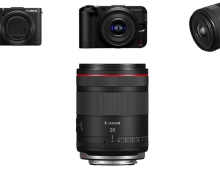
Canon Develops World's Largest CMOS Image Sensor
Canon announced today that it has successfully developed the
world's largest CMOS image sensor, with a chip size measuring
202 x 205 mm.
Because its expanded size enables greater light-gathering
capability, the sensor is capable of capturing images in one
one-hundredth the amount of light required by a
professional-model digital SLR camera.
 At 202 x 205 mm, the newly developed CMOS sensor
is among the largest chips that can be produced from a 12-inch
(300 mm) wafer, and is approximately 40 times the size of
Canon's largest commercial CMOS sensor.
At 202 x 205 mm, the newly developed CMOS sensor
is among the largest chips that can be produced from a 12-inch
(300 mm) wafer, and is approximately 40 times the size of
Canon's largest commercial CMOS sensor.
In the past, enlarging the size of the sensor resulted in an increase in the amount of time required between the receiving and transmission of data signals, which posed a challenge to achieving high-speed readout. Canon, however, solved this problem through a new circuit design, making possible the realization of a massive video-compatible CMOS sensor. Additionally, by ensuring the cleanest of cleanroom environments during the production process, the sensor minimizes image imperfections and dust.
Because the increased size of the new CMOS sensor allows more light to be gathered, it enables shooting in low-light environments. The sensor makes possible the image capture in one one-hundredth the amount of light required by a 35 mm full-frame CMOS sensor, facilitating the shooting of 60 frame-per-second video with a mere 0.3 lux of illumination.
Potential applications for the new high-sensitivity CMOS sensor include the video recording of stars in the night sky and nocturnal animal behavior.
 At 202 x 205 mm, the newly developed CMOS sensor
is among the largest chips that can be produced from a 12-inch
(300 mm) wafer, and is approximately 40 times the size of
Canon's largest commercial CMOS sensor.
At 202 x 205 mm, the newly developed CMOS sensor
is among the largest chips that can be produced from a 12-inch
(300 mm) wafer, and is approximately 40 times the size of
Canon's largest commercial CMOS sensor.
In the past, enlarging the size of the sensor resulted in an increase in the amount of time required between the receiving and transmission of data signals, which posed a challenge to achieving high-speed readout. Canon, however, solved this problem through a new circuit design, making possible the realization of a massive video-compatible CMOS sensor. Additionally, by ensuring the cleanest of cleanroom environments during the production process, the sensor minimizes image imperfections and dust.
Because the increased size of the new CMOS sensor allows more light to be gathered, it enables shooting in low-light environments. The sensor makes possible the image capture in one one-hundredth the amount of light required by a 35 mm full-frame CMOS sensor, facilitating the shooting of 60 frame-per-second video with a mere 0.3 lux of illumination.
Potential applications for the new high-sensitivity CMOS sensor include the video recording of stars in the night sky and nocturnal animal behavior.





















